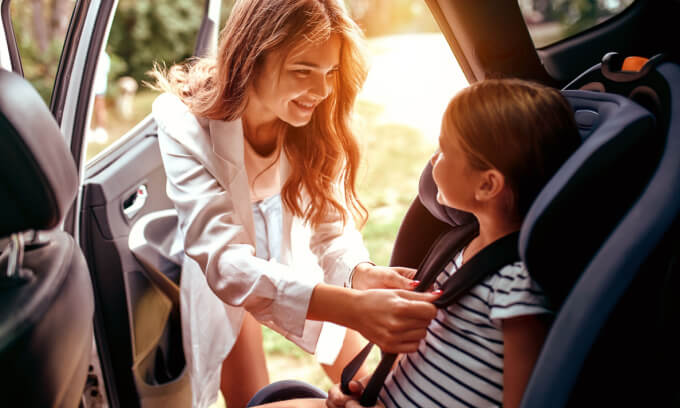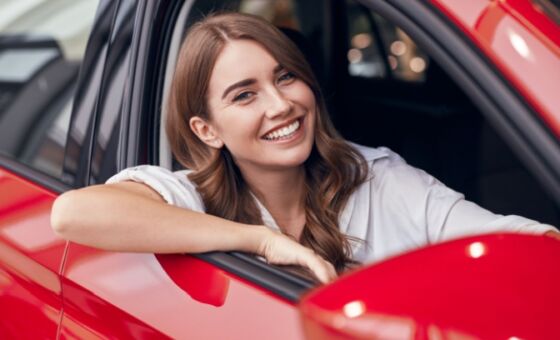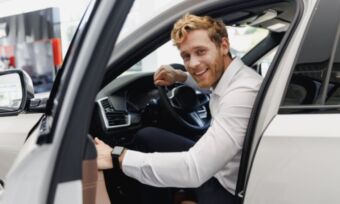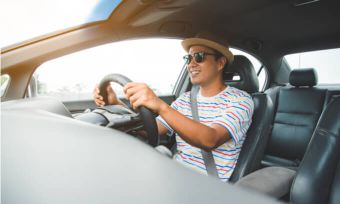What are the safest cars in Australia?
With road accidents resulting in 956 deaths nationwide in the year to 30 September 2024, and many more serious injuries, it’s easy to see why it’s important to know how safe a car is before making a purchase.
Plus, insurers typically take a vehicle’s safety rating into account when calculating their car insurance premiums, alongside a variety of other factors.
What makes a car safe?
While it’s not necessarily true in all cases, a general rule of thumb is that the newer a car is, the safer it is. This is due to car manufacturers incorporating the latest active and passive safety features into new vehicles of all sizes.
Active features are designed to stop an accident from happening. They include:
- Auto emergency braking: Senses an imminent crash and automatically applies the brakes if you don’t respond.
- Lane keeping assist: Helps you keep in between lines by intervening when necessary to manipulate your car’s steering.
- Rear cross detection: A sensor that picks up movement within a field, sounding an alarm (audio or audio and visual) if an object is detected.
- Rear bumper sensor: Alerts you if it senses obstacles nearby while you’re parking.
Passive features are those that only operate during an accident. They include:
- Airbags: Deploy when a major impact is made with another object
- Seat belts: Secure the car’s occupants in their seat, helping them avoid whiplash.
- Crumple zone: The part of the vehicle’s structure designed to crumple in an accident, absorbing most of the impact.
An interesting fact about many modern cars is that they are designed so that if there’s a major impact to the front of the vehicle, the engine dislodges and slips underneath the car. This is designed to prevent the engine from breaking through to the interior and injuring the driver and any passengers.
What are Australia’s safest cars?
Significant effort goes into assessing the safety of on-market vehicles. In Australia, two important information sources are ANCAP (the Australasian New Car Assessment Program), which covers new cars, and the UCSR (Used Car Safety Ratings) system, which covers used cars.
Safest new cars in Australia 2024
At the time of writing, ANCAP has rated 26 vehicles that were tested in 2024 and 2025 as having five stars. These include all kinds of brands, with the most represented being Toyota with three models listed (Camry, C-HR and Prado). The next most represented are BYD, GWM and Mini, with two vehicles listed each.
ANCAP publishes safety ratings for new cars based on the level of safety they provide in the event of a crash and their ability to avoid or minimise the effects of a crash. Vehicles receive a 0–5-star safety rating based on their performance across these test areas:
- Adult occupant protection
- Child occupant protection
- Vulnerable road user protection (i.e. vehicles that score highly here are seen to be designed in a way that causes less injury to a pedestrian in an accident)
- Safety assist (i.e. active and passive safety features).
The 5-Star rated vehicles for 2024 and 2025, in alphabetical order, are:
ANCAP 5-Star rated vehicles for 2024 & 2025
← Mobile/tablet users, scroll sideways to view full table →
| Make and Model | Vehicle Type | Engine/ Fuel Types | Adult Occupant Protection Rating | Child Occupant Protection Rating | Vulnerable Road User Protection Rating | Safety Assist Rating |
|---|---|---|---|---|---|---|
| Audi Q6 e-tron | Medium SUV | Battery electric vehicles | 91% | 87% | 81% | 82% |
| BYD Sealion 7 | Medium SUV | Battery electric vehicles | 87% | 93% | 76td> | 78% |
| BYD Shark 6 | Utility | Plug-in hybrid vehicles | 85% | 87% | 74% | 86td> |
| Deepal S07 | Medium SUV | Battery electric vehicles | 95% | 86% | 74% | 78% |
| Geely EX5 | Medium SUV | Battery electric vehicles | 86% | 87% | 83% | 85% |
| GWM Cannon Alpha | Utility | Petrol/diesel, hybrid and plug-in hybrid vehicles | 84% | 93% | 82% | 81% |
| GWM Tank 500 | Large SUV | Hybrid vehicles | 85% | 93% | 81% | 84% |
| Hyundai Santa Fe | Large SUV | Petrol/diesel and hybrid vehicles | 84% | 86% | 77% | 80% |
| JAV T9 | Utility | Petrol/diesel vehicles | 85% | 87% | 87% | 89% |
| Jaecoo J7 | Small SUV | Plug-in hybrid vehicles | 81% | 85% | 80% | 84% |
| Kia EV5 | Medium SUV | Battery electric vehicles | 88% | 86% | 74% | 82% |
| Leapmotor C10 | Medium S?UV | Battery electric vehicles | 89% | 87% | 77% | 77% |
| Lexus LBX | Small SUV | Hybrid vehicles | 82% | 86% | 79% | 79% |
| Mazda CX-80 | Large SUV | Petrol/diesel and plug-in hybrid vehicles | 92% | 87% | 84% | 83% |
| MG HS | Medium SUV | Petrol/diesel vehicles | 90% | 87% | 83% | 74% |
| Mini Cooper E | Small Car | Battery electric vehicles | 89% | 83% | 77% | 83% |
| Mini Countryman | Small SUV | Petrol/diesel and battery electric vehicles | 83% | 86% | 81% | 83% |
| Mitsubishi Triton | Utility | Petrol/diesel vehicles | 86% | 89% | 73% | 70% |
| Skoda Kodiaq | Large SUV | Petrol/diesel vehicles | 89% | 87% | 82% | 81% |
| Toyota Camry | Medium Car | Hybrid vehicles | 95% | 87% | 84% | 81% |
| Toyota C-HR | Small SUV | Hybrid vehicles | 85% | 88% | 86% | 82% |
| Toyota Prado | Large SUV | Petrol/diesel vehicles | 85% | 89% | 84% | 82% |
| Volkswagen Tiguan | Medium SUV | Petrol/diesel vehicles | 83% | 88% | 84% | 78% |
| Volvo EX30 | Small SUV | Battery electric vehicles | 88% | 85% | 79% | 80% |
| XPENG G6 | Small SUV | Battery electric vehicles | 88% | 86% | 81% | 80% |
| Zeekr X | Small SUV | Battery electric vehicles | 91% | 87% | 84% | 84% |
Source: ANCAP Safety Ratings. Percentage ratings based on a point system calculated by the vehicle’s results for key safety metrics.
Ultimately, ANCAP recommends the safest vehicle you can afford with 5 stars and the latest rating year when buying a new car, as ANCAP’s rating criteria continues to become more stringent as the years go on. This is why it can be important to recognise the test year and different testing scores that a car receives as well as its star rating.
Safest used cars in Australia
The UCSR scheme, which is overseen by the Vehicle Safety Research Group, provides used car safety ratings based on data from real-world crashes investigated by the Monash University Accident Research Centre.
The ratings system considers three components of vehicle safety performance:
- Driver Safety rating: how well the vehicle protects its driver from being killed or seriously injured in a crash.
- Other Road User Safety rating: how well the vehicle protects other drivers, pedestrians, cyclists and motorcyclists from being killed or seriously injured in a crash.
- Crash Avoidance rating: the reduction in likelihood of being involved in a crash through key crash avoidance technologies being available in the vehicle.
Monash’s most recent report is the 2024 Used Car Safety Ratings. It doesn’t have overall rankings – instead, it rates cars within their vehicle type category.
The rating scale ranges from 1 to 5 stars, with the lowest performing 20% in a category receiving 1 star (very poor) and the top 20% receiving 5 stars (excellent). Vehicles can potentially also receive a ‘Safer Pick’ marker, which is assigned to vehicles that score a 5-star Overall Safety rating, a 5-star Driver Protection rating and at least a 4-star rating for both Other Road User Safety and Crash Avoidance.
In this most recent report, 110 vehicles were awarded 5 stars and 54 of these received ‘Safer Pick’ status. This year’s report also included the “Light” car category. The category for commercial vans had no 5 star vehicles and the category for commercial utes only had one, being the Holden Commodore VF Ute.
The 5-star winners in each other category, with those receiving a safer pick mark denoted with the * symbol in their model section, are:
Light Cars
← Mobile/tablet users, scroll sideways to view full table →
| Make | Model | Year range | Driver Safety rating | Other Road Safety rating | Crash Avoidance rating |
|---|---|---|---|---|---|
| Mini | MkII Hatch/ Hardtop | 2007-2013 | 5 | 5 | 3 |
| Peugeot | 207 | 2007-2012 | 5 | 4 | 3 |
| Toyota | Prius C | 2012-2020 | 5 | 5 | 3 |
Source: 2024 Used Car Safety Ratings.
Small Cars
← Mobile/tablet users, scroll sideways to view full table →
| Make | Model | Year range | Driver Safety rating | Other Road Safety rating | Crash Avoidance rating |
|---|---|---|---|---|---|
| Audi | A3/S3 | 2004-2013 | 5 | 5 | 3 |
| BMW | 1 Series | 2004-2013 | 5 | 4 | 3 |
| BMW | 1 Series* | 2011-2019 | 5 | 5 | 4 |
| Holden | Astra* | 2016-2020 | 5 | 5 | 4 |
| Honda | Civic* | 2016-2021 | 5 | 5 | 5 |
| Hyundai | Elantra* | 2015-2020 | 5 | 4 | 4 |
| Hyundai | Accent | 2011-2019 | 4 | 5 | 3 |
| Hyundai | i30 | 2012-2017 | 4 | 5 | 3 |
| Mazda | 3/Axela* | 2013-2019 | 5 | 5 | 5 |
| Mercedes-Benz | A-Class W176 | 2012-2018 | 5 | 5 | 3 |
| Mercedes-Benz | B-Class W246 | 2012-2018 | 5 | 3 | 3 |
| Peugeot | 308 | 2008-2013 | 4 | 5 | 3 |
| Subaru | Impreza/ XV | 2012-2016 | 5 | 4 | 3 |
| Subaru | Impreza/ XV* | 2016-2022 | 5 | 5 | 5 |
| Toyota | Corolla* | 2018-2022 | 5 | 5 | 5 |
| Toyota | Prius 3 | 2009-2016 | 5 | 5 | 3 |
| Toyota | Prius V* | 2012-2021 | 5 | 5 | 4 |
Source: 2024 Used Car Safety Ratings. Models that received a safer pick mark are denoted by the * symbol.
Medium Cars
← Mobile/tablet users, scroll sideways to view full table →
| Make | Model | Year range | Driver Safety rating | Other Road Safety rating | Crash Avoidance rating |
|---|---|---|---|---|---|
| Audi | A4/S4/RS4/ AllRoad* | 2008-2015 | 5 | 5 | 5 |
| Audi | A5/S5/RS5* | 2007-2016 | 5 | 4 | 4 |
| Ford | Mustang* | 2015-2022 | 5 | 4 | 5 |
| Kia | Optima* | 2011-2015 | 5 | 5 | 4 |
| Mazda | 6/Atenza* | 2012-2022 | 5 | 5 | 5 |
| Mercedes-Benz | C-Class W204/ C204* | 2007-2015 | 5 | 4 | 4 |
| Mercedes-Benz | C-Class W205/ S205/C205/A205* | 2014-2022 | 5 | 5 | 4 |
| Mercedes-Benz | CLK C209/A209 | 2003-2009 | 5 | 4 | 3 |
| Mercedes-Benz | CLA-Class C117/ X117* | 2013-2019 | 5 | 5 | 5 |
| Peugeot | 407 | 2004-2011 | 5 | 2 | 3 |
| Subaru | Liberty/Legacy/ Outback/Exiga* | 2009-2014 | 5 | 4 | 4 |
| Toyota | Camry* | 2011-2017 | 5 | 4 | 4 |
| Toyota | Camry* | 2017-2022 | 5 | 5 | 5 |
| Volkswagen | Passat | 2006-2015 | 5 | 3 | 3 |
| Volkswagen | Eos | 2007-2014 | 4 | 5 | 3 |
| Volvo | S60 | 2000-2009 | 5 | 5 | 3 |
Source: 2024 Used Car Safety Ratings. Models that received a safer pick mark are denoted by the * symbol.
Large Cars
← Mobile/tablet users, scroll sideways to view full table →
| Make | Model | Year range | Driver Safety rating | Other Road Safety rating | Crash Avoidance rating |
|---|---|---|---|---|---|
| Ford | Falcon FG/ FG-X* | 2008-2016 | 5 | 4 | 4 |
| Holden | Statesman/ Caprice WN | 2013-2017 | 5 | 3 | 4 |
| Holden | Commodore VF | 2013-2017 | 5 | 3 | 4 |
| Lexus | GS | 1997-2004 | 5 | 5 | 1 |
| Mercedes-Benz | E-Class W212/ C207/A207* | 2009-2016 | 5 | 5 | 5 |
Source: 2024 Used Car Safety Ratings. Models that received a safer pick mark are denoted by the * symbol.
Small SUVs
← Mobile/tablet users, scroll sideways to view full table →
| Make | Model | Year range | Driver Safety rating | Other Road Safety rating | Crash Avoidance rating |
|---|---|---|---|---|---|
| Audi | Q3/RS* | 2012-2019 | 5 | 5 | 4 |
| BMW | X1 | 2010-2015 | 5 | 3 | 3 |
| BMW | X1* | 2015-2022 | 5 | 5 | 4 |
| Ford | EcoSport* | 2013-2019 | 5 | 5 | 4 |
| Hyundai | Tucson* | 2015-2020 | 5 | 5 | 5 |
| Hyundai | Kona* | 2017-2022 | 4 | 5 | 5 |
| Jeep | Compass | 2007-2017 | 5 | 5 | 3 |
| Kia | Sportage* | 2010-2015 | 5 | 5 | 4 |
| Mazda | CX-3* | 2015-2022 | 5 | 5 | 4 |
| Mercedes-Benz | GLA-Class X156* | 2014-2019 | 5 | 5 | 5 |
| Mitsubishi | ASX* | 2016-2019 | 5 | 5 | 4 |
| Mitsubishi | ASX* | 2019-2022 | 5 | 5 | 4 |
| Nissan | Juke* | 2013-2019 | 5 | 5 | 4 |
| Suzuki | Vitara* | 2015-2022 | 5 | 5 | 4 |
| Toyota | C-HR | 2016-2022 | 5 | 3 | 5 |
| Volkswagen | Tiguan* | 2016-2022 | 5 | 5 | 5 |
Source: 2024 Used Car Safety Ratings. Models that received a safer pick mark are denoted by the * symbol.
Medium SUVs
← Mobile/tablet users, scroll sideways to view full table →
| Make | Model | Year range | Driver Safety rating | Other Road Safety rating | Crash Avoidance rating |
|---|---|---|---|---|---|
| Audi | Q5/SQ5 | 2009-2016 | 5 | 3 | 5 |
| BMW | X3* | 2004-2010 | 5 | 5 | 4 |
| BMW | X3 | 2010-2017 | 5 | 1 | 4 |
| Ford | Territory | 2011-2016 | 5 | 3 | 4 |
| Ford | Kuga* | 2013-2016 | 5 | 5 | 4 |
| Honda | CR-V* | 2012-2017 | 5 | 4 | 4 |
| Honda | CR-V* | 2017-2022 | 5 | 5 | 4 |
| Hyundai | Santa Fe* | 2012-2018 | 5 | 4 | 5 |
| Jeep | Cherokee* | 2014-2022 | 5 | 4 | 5 |
| Jeep | Wrangler* | 2007-2018 | 5 | 4 | 4 |
| Lexus | RX | 2009-2015 | 5 | 2 | 5 |
| Lexus | NX* | 2014-2021 | 5 | 4 | 5 |
| Mazda | CX-5* | 2012-2017 | 5 | 4 | 5 |
| Mazda | CX-5* | 2017-2022 | 5 | 5 | 5 |
| Mercedes-Benz | GLC-Class X253/C253 | 2015-2022 | 5 | 2 | 5 |
| Mitsubishi | Outlander* | 2012-2021 | 5 | 5 | 5 |
| Mitsubishi/Peugeot | Outlander/ 4007 | 2006-2012 | 5 | 3 | 4 |
| Nissan | X-Trail | 2014-2022 | 4 | 5 | 5 |
| Porsche | Cayenne* | 2010-2017 | 5 | 4 | 4 |
| Porsche | Macan | 2014-2022 | 5 | 2 | 5 |
| Renault | Koleos | 2008-2016 | 5 | 2 | 4 |
| Land Rover | Freelander 2* | 2007-2014 | 5 | 5 | 4 |
| Land Rover | Range Rover Evoque* | 2011-2018 | 5 | 4 | 5 |
| Subaru | Forester | 2012-2018 | 5 | 3 | 5 |
| Suzuki | Grand Vitara | 2008-2018 | 5 | 3 | 4 |
| Toyota | RAV4* | 2013-2019 | 5 | 4 | 4 |
| Toyota | Kluger/ Highlander | 2013-2020 | 5 | 2 | 5 |
| Toyota | FJ Cruiser* | 2011-2016 | 5 | 5 | 4 |
| Volvo | XC60 | 2009-2017 | 5 | 3 | 4 |
Source: 2024 Used Car Safety Ratings. Models that received a safer pick mark are denoted by the * symbol.
Large SUVs
← Mobile/tablet users, scroll sideways to view full table →
| Make | Model | Year range | Driver Safety rating | Other Road Safety rating | Crash Avoidance rating |
|---|---|---|---|---|---|
| Audi | Q7 | 2006-2014 | 5 | 1 | 5 |
| BMW | X5 | 2001-2006 | 5 | 3 | 4 |
| BMW | X5 | 2007-2013 | 5 | 3 | 4 |
| BMW | X5/X5M | 2013-2017 | 5 | 3 | 4 |
| Dodge/Fiat | Journey/ Freemont | 2008-2016 | 5 | 2 | 4 |
| Isuzu | MU-X | 2013-2021 | 5 | 2 | 5 |
| Jeep | Grand Cherokee* | 2010-2021 | 5 | 4 | 5 |
| Land Rover | Discovery 4 / Discovery | 2009-2016 | 5 | 1 | 5 |
| Mazda | CX-9* | 2016-2022 | 5 | 4 | 5 |
| Mercedes-Benz | ML/GL-Class W164/X164 | 2005-2011 | 5 | 2 | 4 |
| Mercedes-Benz | ML/GL/GLE/ GLS-Class W166/ X166/X167/C292 | 2012-2022 | 5 | 2 | 5 |
| Mitsubishi | Pajero Sport | 2015-2022 | 5 | 3 | 5 |
| Nissan | Pathfinder* | 2013-2020 | 5 | 4 | 5 |
| Land Rover | Range Rover Sport | 2005-2013 | 5 | 3 | 4 |
| Toyota | Landcruiser Prado | 2009-2022 | 5 | 2 | 5 |
| Volkswagen | Touareg* | 2011-2019 | 5 | 5 | 5 |
| Volvo | XC90 | 2003-2015 | 5 | 2 | 4 |
Source: 2024 Used Car Safety Ratings. Models that received a safer pick mark are denoted by the * symbol.
People Movers
← Mobile/tablet users, scroll sideways to view full table →
| Make | Model | Year range | Driver Safety rating | Other Road Safety rating | Crash Avoidance rating |
|---|---|---|---|---|---|
| Chrysler | Grand Voyager | 2001-2007 | 5 | 4 | 2 |
| Honda | Odyssey* | 2013-2021 | 5 | 5 | 5 |
| Kia | Carnival | 2014-2020 | 5 | 1 | 4 |
| Kia | Grand Carnival | 2006-2015 | 5 | 3 | 3 |
| Mazda | MPV | 2000-2006 | 5 | 3 | 1 |
Source: 2024 Used Car Safety Ratings. Models that received a safer pick mark are denoted by the * symbol.
How do safety ratings affect car insurance premiums?
How your car rates for safety can have a significant influence on how your car insurance premium is calculated—but it’s not a golden ticket. Insurance companies generally follow a multi-layered process to determine policy pricing, with many variables that may be involved.
Bear in mind that different insurers may ask different questions, or rate answers differently when calculating car premiums. For instance, some may heavily weigh the car’s overnight parking location while others focus more on other factors, such as your driving and claims history.
Aspects that may or may not be taken into account include:
- Vehicle type (i.e. year, brand/make, model, series etc.) and how likely it is to be involved in accidents, according to research data
- The geographic location where the car will be based and/or garaged (e.g. some insurers reduce premiums for motorists who live and park their car in a relatively safe neighbourhood)
- The driver’s age, gender and other personal circumstances (such as their driving history, claims history and whether they’re the only driver on their policy)
- How the vehicle will be used (e.g. for business or personal use, whether it will be driven in high-traffic periods)
- If the car has any pre-existing damage
- If the car has any modifications or accessories
- Kilometres travelled per year, with some offering discounts for driving under a certain limit (often referred to as ‘pay as you drive’).
Other factors that can affect pricing include:
- If you’re a first time customer (some providers have specific deals and discounts for this)
- If you’re insuring more than one ‘risk item’ with the provider (e.g. through a multi-vehicle policy or multi-policy discount)
- Whether you pay the premium upfront or in monthly instalments (i.e. a number of providers offer discounts to customers who pay their annual premiums in full).
What optional safety features could reduce my car insurance premium?
Some providers may allow discounts on premiums for cars with additional safety features, but many don’t.
Strategies to help prevent car theft such as using self-arming immobilisers and steering wheel, pedal or tyre locks won’t necessarily translate to lower premiums. But, they may provide you with extra peace of mind.
Before you add any safety features to your car, it could be worth checking the impact they could have on your insurance. As well as their safety benefits, it may be worth also thinking about their potential financial benefits—will it add value or save you money in some way?
You should also be aware that post-manufacturing modifications may actually increase your premium. This is due to high-tech add-ons, such as throttle controllers and autonomous braking, being pricey to repair if damaged in an accident.
So, what makes a safe car? Everything from how it’s designed and manufactured to the way you drive, service and maintain it can influence how safe it is to drive. The onus is on the driver (and your mechanic) as well as the manufacturer.
What makes for a lower insurance premium? Exploring all the factors that influence the premium calculation process can be a good place to start. An open conversation with each insurer you’re considering will often assist greatly as well.
Compare Top-Rated Car Insurance
Are driverless cars safe?
The advent of driverless cars raises some important questions about safety and liability. Removing human error and increasing a car’s ability to react quickly will increase safety, at least in theory. However, autonomous vehicles can’t recognise how some fellow road users might react, nor can they understand communication from human drivers around them. They also sometimes struggle in dim light or when making a turn, and there may be gaps in their driving knowledge. For example, a pedestrian fatality highlighted that the driverless car involved wasn’t programmed to know people might illegally cross the road (jaywalk).
Compare car insurance policies
If you’re comparing car insurance policies, the comparison table below displays some of the policies currently available on Canstar for a 30-39 year old male seeking comprehensive cover in NSW without cover for an extra driver under 25. Please note the table is sorted by Canstar Star Rating (highest to lowest) followed by provider name (alphabetical) and features links direct to the providers’ websites. Consider the Product Disclosure Statement (PDS) and Target Market Determination (TMD), before making a purchase decision. Contact the product issuer directly for a copy of the PDS and TMD. Use Canstar’s car insurance comparison selector to view a wider range of policies. Canstar may earn a fee for referrals
- Save 15%^ on your first year’s premium when you purchase a new Car Insurance policy online.
- 24/7 Phone & Online Claims.
- Budget Direct - Insurance Solved.
- Insurance that's a bit more you-shaped.
- Canstar’s 2025 Most Satisfied Customer Car Insurance – NSW, VIC, SA
- Lodge a Claim 24/7 with our Advisors
- Flexible cover before, 24/7 claims after.
- Save $75 on new Comprehensive car insurance online.
- Conditions apply.
- No age-based excess.
- No excess on your first covered windscreen repair.
- Canstar 2025 Outstanding Value Car Insurance Award.
- Collect 10,000 Flybuys Points with a new Comprehensive Car Insurance Policy for Flybuys members. Ends 30/1/26. T&Cs, Excl Apply.
- Earn up to 40,000 Qantas Points with every car insurance policy. Ends 28 Jan. Plus save 15% on your 1st year’s premium when you purchase online. T&Cs apply.
Cover image source: ORION PRODUCTION/Shutterstock.com








